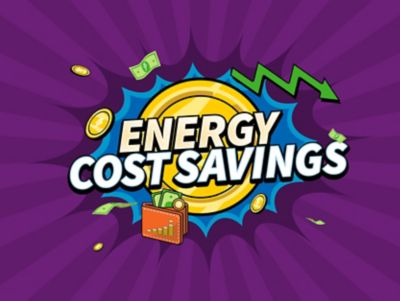Methods of energy savings in air compressors
How much can I save?
Energy-saving compressors reduce expenses. By using significantly less energy, they reduce the production cost of compressed air. Since most of a compressor’s total cost of ownership comes from the energy costs, these cost reductions can have a big impact on your energy bill. But is there a way to calculate exactly how much a business can save by going green?
This is a particularly important question for smaller companies, which may be worried about the higher initial purchase price of an energy-efficient compressor. To them, it might seem that the “safe” option would be to keep using their old compressor even though it generates a massive electric bill.
However, there is nothing safe about sticking with old technology at a time when those who decide to go green are enjoying a significant competitive advantage. In fact, not switching to environment-friendly technology is much riskier because it invites uncertainty to production processes.
Green air compressors provide stability. They do not just guarantee that a company will lower the production cost of compressed air – and therefore are more protected from highly fluctuating energy prices – they also offer greater reliability, longer maintenance intervals and ensure compliance with current and upcoming emissions standards.
Getting help to determine specific savings
In most cases, the direct and indirect savings and benefits of switching to a green compressor will be substantial – especially the lower production cost of compressed air as a result of an energy cost reduction.
The specific figure depends on factors such as a company’s compressed air needs or the type of compressor they choose.
For example; a variable speed drive compressor versus fixed speed compressors. With that information, our experts can help calculate how much a business can save by buying a green air compressor.
How to achieve air compressor energy savings?
Making plant compressed air savings
Going green is not just about buying a new compressor. Optimizing their existing compressed air network typically offers businesses more than one option to reduce energy consumption and the cost of compressed air. A compressed air system requires attention and care. Neglecting it will invariably lead to inefficiencies that can be quite costly.
- That is why a compressed air system should be carefully monitored and controlled. A simple example is that of the working air pressure. A higher pressure means an increased energy use, which means higher operating costs. On average, 1 extra bar of pressure results in an average of 8 percent more power required. That quickly adds up.
Many companies make the mistake of simply increasing their working air pressure when there is a pressure drop in their air system. While that seems like an easy solution, it is also an expensive one and quickly leads to an increase in the cost of compressed air. For example, a two-millimeter leak at a pressure of 8 bar can cost a business thousands of dollars annually. - That is why investigating the causes for the pressure drop, which could be anything from a leak to an under-dimensioned pipe system, old equipment or a clogged filter, is key. This means operators should always be aware of how much pressure they actually require and where their system may lose pressure. As a rule of thumb, the compressed air network should be designed so that the loss of pressure between the compressor and the most distant piece of equipment that consumes the air should be no greater than 0.1 bar. Anything else will quickly be reflected in a company’s electric bill.
A good way to manage a compressed air system is the use of a state-of-the-art master control system that monitors its efficiency, availability and reliability. It cannot only detect problems but also automatically reduce the working pressure, i.e. reduce costs, when the air demand is low, for example at night or on weekends. - Another good way to cut costs is to add an energy recovery system to the compressed air network. More than 90 percent of the energy a compressor uses can be recovered in the form of heat, which can be utilized elsewhere. As a result, the investment for such a system often pays for itself in less than three years.
The most important thing to remember is that nearly any compressed air network can be improved, especially those that do not use state-of-the-art equipment and cutting-edge controllers. And for even more savings, check in with an Atlas Copco expert to find out how your company can benefit from going green.
See the carbon footprint impact of your energy savings
Step 1: Select your currency and unit of measurement
Step 2: Fill in your annual running hours, system power, and electrical cost per hour
Step 3: Choose the percentage of energy saving
1 bar air pressure band reduction: 7%
Changing from fixed speed to VSD: 35%
Changing from fixed speed to VSD+: 50%
Installing an energy recovery system: 94%
Step 4: Select the numbers of years to visualize saving over time
Have a look at the estimation of your reduction in electricity costs and your CO2 reduction. To make it more tangible, we visualized the reduction in CO2 in more common comparisons such as CO2 emissions from charged smartphones and a households' yearly electricity use.


